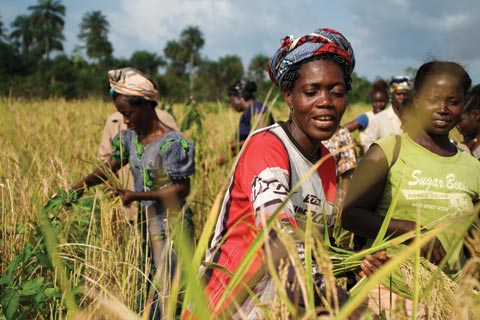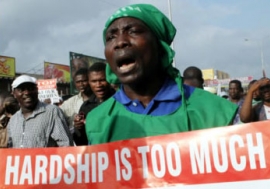Investing in Africa's farms — and its future
Investing in Africa's farms — and its future
 Farmers harvesting rice in Liberia, one of the countries that has signed a "CAADP Compact" pledging increased government funding for agricultural development.
Farmers harvesting rice in Liberia, one of the countries that has signed a "CAADP Compact" pledging increased government funding for agricultural development.For most of the 1990s Sierra Leone was best known for its diamonds — and the devastating civil war that the scramble for those precious gems helped to sustain. But a decade after the end of that conflict, the West African nation is tapping a different kind of wealth: the crops that can grow on its fertile land.
For Marie Kargbo, who cultivates rice on a six-hectare farm in Kambia district in northwestern Sierra Leone, bountiful harvests are a direct result of increased government support. "Before now, life for women farmers was very difficult," she told a reporter for the Inter Press Service news agency. "But now rice production has been fruitful, as we have been receiving supply from the government, ranging from seed rice [to] power tillers, fertilizers and pesticides."
In 2009, according to the latest estimates of the UN Food and Agriculture Organization (FAO), Sierra Leone grew 784,000 tonnes of rice, well above the 550,000 tonnes needed for domestic consumption and a third higher than the previous five-year average. The absence of war is one factor, since it allows farmers to tend their crops in peace. Rainfall, while erratic, has generally been sufficient as well.
But perhaps the most important element has been the government's enhanced support for agriculture. In 2008 President Ernest Bai Koroma, who had just been elected the year before, declared that agriculture would be his administration's second-highest development priority (after energy).
The government put money behind that talk by increasing agriculture's share of the 2009 budget to 7.7 per cent, a dramatic leap from just 1.6 per cent the previous year. The 2010 budget pushed up the share further, to 10 per cent.
With that step, Sierra Leone became just one of a dozen African countries to reach the target for agricultural spending recommended by African governments at a 2003 summit meeting in Maputo, Mozambique. That summit also approved a detailed plan for African agriculture known as the Comprehensive African Agricultural Development Programme (CAADP), which is part of the New Partnership for Africa's Development (NEPAD), the African Union's continental development programme (see Africa Renewal, January 2004).
Sierra Leone's own agricultural initiative was directly inspired by CAADP. When the government formally signed a CAADP Compact in September 2009 to mark its commitment to the programme, President Koroma declared, "This is an important historical moment not only for Sierra Leone, but for Africa as a whole. We regard CAADP as being pivotal to our poverty and hunger eradication efforts."
Averting a food crisis
For Sierra Leone and the rest of Africa, this is a critical time. In early February the FAO reported that its food price index had increased for the seventh consecutive month. It was not only higher than during the peak of the 2007–08 global food crisis (see Africa Renewal, July 2008), but also the highest since the UN agency began tracking global prices in 1990.
Africa, cautioned UN Secretary-General Ban Ki-moon in a November 2010 report* on the "social dimensions" of NEPAD, is especially vulnerable to such price increases. Since most African countries do not produce enough food of their own, he estimated, the continent spends about $33 bn annually importing food. Poor people, who spend a disproportionate share of their meagre incomes on food, are hit especially hard. "The state of food and nutrition security across much of Africa remains fragile," Mr. Ban emphasized.
President Bingu wa Mutharika of Malawi, who served as chairperson of the African Union in 2010, pointed to the broader implications of food insecurity when addressing a conference of African agriculture ministers in Lilongwe, Malawi, in October. "Without food," he said, "children cannot learn well in schools; without food, the labour force cannot be productive; without food, you cannot maintain the police service and national defence forces...."
 Irrigated farming in Kilimanjaro, Tanzania: Expanding waterworks and other rural infrastructure is vital for increasing production and sustainable land management.
Irrigated farming in Kilimanjaro, Tanzania: Expanding waterworks and other rural infrastructure is vital for increasing production and sustainable land management.Economic backbone
But Africa need not remain hungry. With increased investment, better agricultural policies and more support for Africa's farmers, the continent can achieve an agricultural revolution, says Ibrahim Assane Mayaki, the chief executive officer of the NEPAD Planning and Coordination Agency. "Africa has the potential to become a major food producer, ensuring food security on our continent and beyond."
Boosting agricultural production is not only vital for reducing hunger in Africa, notes the CAADP programme, "but it also makes economic sense." In virtually every African country — including most of those blessed with oil and minerals — agriculture constitutes the backbone of the economy. The size of the harvest is often the most decisive factor in overall economic growth, and CAADP recommends that the farm sector should grow by an average of at least 6 per cent a year.
Yet for decades African agriculture suffered from neglect. Many governments devoted only a minuscule percentage of their budgets to farming, and donor funding shifted away from agriculture to other sectors.
In recent years donors have promised more financing. At a 2009 summit of the Group of Eight industrial powers in L'Aquila, Italy, their leaders pledged some $22 bn in international agricultural aid, much of it for Africa, within three years. But with the global economy still suffering from the impact of the 2008 financial crisis, that promise is materializing only very slowly.
That makes it even more important for African governments to do their part, argues Mr. Mayaki. "We all have to make the necessary funding available. We need to increase our levels of investment into agriculture in Africa."
Agricultural 'compacts'
In 2007, CAADP's promoters launched a campaign to get African governments to publicly commit themselves, at the highest levels, to the targets set by the Maputo summit. As of that point, according to an African Union/NEPAD survey, only eight African governments (Comoros, Ethiopia, Madagascar, Malawi, Mali, Niger, Senegal and Zimbabwe) were devoting 10 per cent or more of their budgets to agriculture.
That year, Rwanda became the first country to sign a formal CAADP Compact. Under it the ministers of finance and agriculture vowed to increase the share of government spending for agricultural development from 4 per cent to more than 10 per cent within five years (it had reached 7 per cent by 2010). The ministers, as well as signatories from the private sector and civil society, also pledged to be guided in their activities by CAADP's four thematic "pillars" (expanding land area and water systems under sustainable management, increasing food supply, improving rural infrastructure and market access, and promoting agricultural research).
Slowly at first, other African governments also signed compacts. The campaign accelerated in 2009, as 12 signed that year. By late 2010 the total had increased to 22, with another six governments expected to sign by April 2011. In November 2009 the first regional compact was signed, by the Economic Community of West African States.
Signing the compacts is just a first step. Most governments subsequently hold consultations with farmers' organizations, technical experts, researchers, donor officials, business representatives and others to develop detailed, multi-year investment plans.
More inputs equal bigger harvests
However much governments spend on agriculture, the real test is whether those funds reach farmers on the ground, to help them increase their productivity. In country after country, experience has shown that farmers' access to key inputs — especially fertilizer, high-yielding seeds and irrigation — can be crucial in boosting their harvests. Government subsidies may be helpful in making such inputs affordable for poor farmers, an approach pioneered by Malawi (see box).
In 2009 Mozambique distributed 7,300 oxen as part of a programme to expand the use of animal traction, a measure that should enable families to cultivate at least five hectares each, instead of the current average of just one. Also in 2009 Uganda recorded its best-ever maize harvest. "We distributed enormous quantities of good-quality high-yielding seeds," explained Opolot Okasai, the government's commissioner for crop resources. In 2010, thanks to continued seed distribution, the maize harvest was even higher, nearly twice domestic consumption needs. Much of the remainder was exported to South Sudan and the eastern part of the Democratic Republic of the Congo.
In Tanzania, greater use of hybrid seeds and fertilizers enabled farmers to produce a surplus rice crop in 2010. That same year Senegalese rice farmers, who generally produce only about 150,000 tonnes annually, were able to grow 350,000 tonnes, about half the country's rice consumption. In addition to more seeds and fertilizers, a well-funded farm irrigation programme proved decisive.
Particular care must be taken that such assistance reaches women farmers, experts point out. Whether agricultural services are to provide quality seeds, affordable fertilizers, marketing assistance or credit, they "must give the necessary support to the women farmers, who produce the majority of Africa's food," says Namanga Ngongi, president of the Alliance for a Green Revolution in Africa, a non-governmental rural development initiative launched by former UN Secretary-General Kofi Annan.
More generally, farmers' groups must gain a greater voice in helping to decide and implement agricultural policies and programmes, Mr. Mayaki, the NEPAD chief executive, said at the first Pan-African Farmers Forum, held in Malawi in October 2010. The participants included representatives of national farmers' unions and five regional farmers' organizations. "Farmers," Mr. Mayaki said, "have an important role in ensuring the good application of the NEPAD fundamentals — transparency, accountability and local ownership."
Malawi's example of success
Most African farmers are too poor to afford essential agricultural inputs. So Malawi, beginning in 2005, embarked on an innovative solution: to provide government subsidies to reduce the retail costs of fertilizers and high-yielding maize seeds for smallholders (see Africa Renewal, October 2008).
Despite scepticism from the World Bank and some Northern donor agencies, President Bingu wa Mutharika persisted, and maize harvests grew dramatically. A country that once suffered periodic food shortages is now producing far more maize than it consumes, and can even give food aid to other African countries.
This turnaround has also boosted rural incomes. In 2009 Malawi's Ministry of Finance estimated that during the previous four years the share of Malawians living below the poverty line fell from 52 per cent to 40 per cent.
Other African countries have followed Malawi's example in subsidizing inputs for poor farmers. When President Mutharika became chair of the African Union in 2010, he used that platform to urge African governments to increase their agricultural budgets and provide more farm inputs. A March 2010 meeting of African ministers of finance, economic planning and development, held in Lilongwe, Malawi, recommended that governments subsidize small-scale farmers and stabilize markets for those who produce surpluses.”












